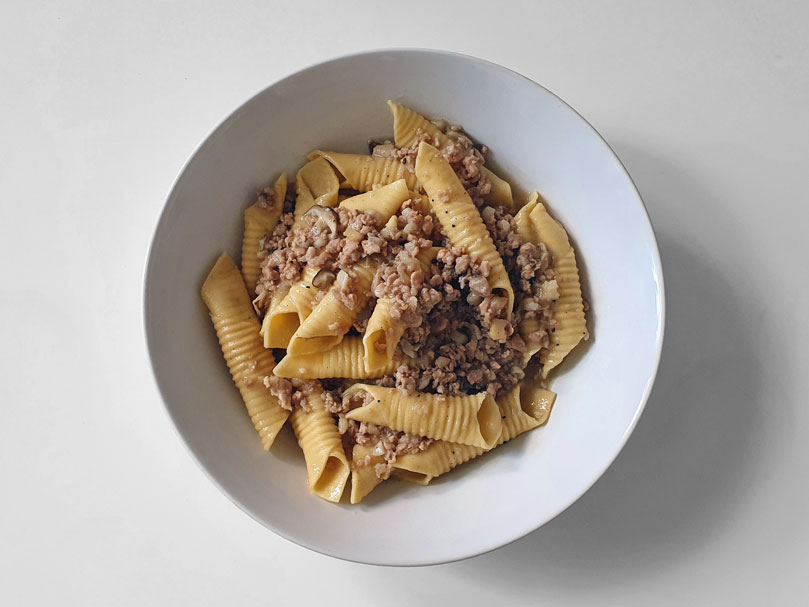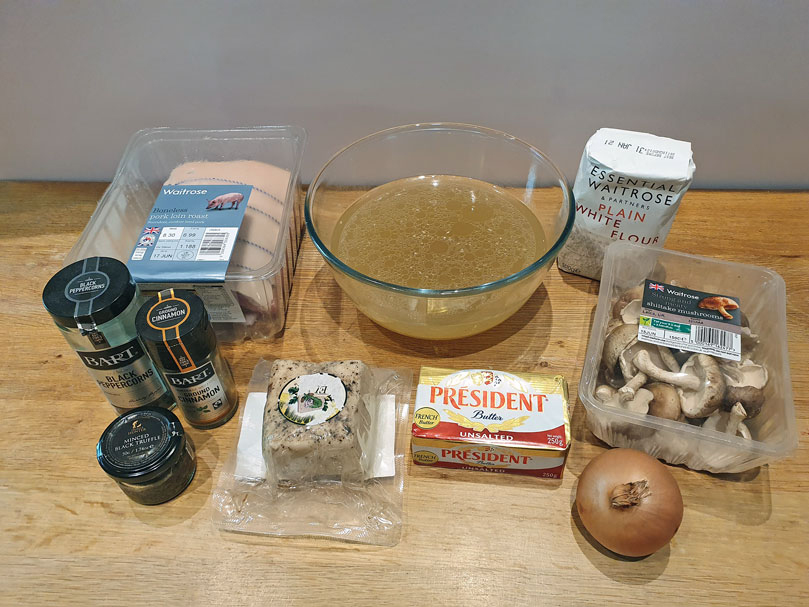
An important and embryonic version of our favourite dish was recorded in the late 18th century by Alberto Alvisi. His recipe is important as it is the first documented account of a ragù being served with pasta.
Bolognan journalists Aureliano Bassani and Giancarlo Roversi resurrected these recipes in their 1994 book:
The dish was called “ragù per i maccheroni appasticciati” or “ragù for sloppy maccheroni”.
“Sloppy” is a fairly accurate description for this little slice of history, as the dish borders on being inedible. The original recipe provides options for the meat base of either veal, pork loin or finely minced chicken gizzard which is to be paired with an excessive quantity of brodo (stock) and (unfortunately) an unappetising volume of flour.
In this recipe I go for pork loin, which is admittedly not the best protein for a low-and-slow cook.
The recipe was retold in Lynne Rossetto Kasper’s book “The Splendid Table”, this time called “The Cardinal’s Ragu”. Kasper’s dish is a slightly more refined version of the original, favouring the more appropriate beef skirt or chuck steak and toning down the flour quantities.
Alvisi provides some optional extras which I added to my ragù. Mushrooms and truffles increase the flavour, but nothing can shout over the wallpaper paste texture we’re asked to produce under Alvisi’s instructions.
Although the flavour wasn’t what I’d hoped for, it served as an interesting historical curiosity for a couple of reasons.
Firstly, you will notice from the ingredients list that not so much as a tomato pip makes it into the sauce. At the time Italian cuisine had largely been left untouched by the ingredient we now associate with the country.
Secondly, the pasta cooking norms of the time point to an expectation for very long cooking times. 18th century pasta preparation could require hours of boiling.
I’m happy to leave this dish in the past but I’m glad I got to sample it and appreciate its importance in the Bolognese story.
Click here now to read the full The Bolognese Story!
Ingredients
Serves 2 with leftover sauce.
Sauce can be refrigerated or frozen.
Ragù (serves 4)
The ragù can be refrigerated or frozen, the pasta can be stored in a cool place for a couple of days or refrigerated or frozen as pasta dough.
- 30g Italian lardo
- 30g unsalted butter
- 1 medium onion
- 400g pork loin
- 875ml (7 x 125ml ladle fulls) brodo (see this recipe for details of how to prepare a Bolognan brodo)
- 30g plain white flour
- 50g shiitake mushrooms (or any other variety)
- ½ teaspoon pepper
- ½ teaspoon cinnamon
- 1 teaspoon minced black truffle
- Salt
Garganelli (serves 2)
- 200g tipo 00 white flour
- 2 medium eggs
- Pinch of salt
- 200ml brodo
- 200ml water

Directions
Ragù
- Remove the skin from the pork loin using a sharp knife and slice the meat into small cubes.
- Using a mezzaluna, grind the pork into a coarse mince1.
- Mince the lardo with a mezzaluna2 and set aside.
- Finely slice the onion and mince further with the mezzaluna.
- Chop the mushrooms into small pieces.
- Bring a medium pan3 to a medium heat and add the butter and lardo, fry the onions for 10 minutes or until translucent.
- Add the minced pork and cook until browned4 all through, stirring regularly.
- Spoon in a ladle full of brodo and a pinch of flour and stir until the flour has dispersed. Repeat this process until all the flour is used5 and the consistency is that of single cream.
- Add the mushrooms, cinnamon6, pepper and black truffle7. Stir well, reduce to a low heat and bring the ragù to a slow bubble. Allow the flavours to combine for at least 10 minutes8.
Garganelli
- Create a flour crater on a large wooden chopping board, or clean kitchen surface. Crack 2 eggs into the crater and whisk with a fork and add a pinch of salt.
- Once the egg mix begins to stiffen up, start kneading the dough with your hands1, pushing the dough ball into all the flour so that it is eventually part of the dough ball.
- After 5-10 minutes of kneading, wrap the dough ball in cling film and leave to rest in the fridge.
- Roll the ball into a single rectangular sheet with a rolling pin2.
- Pass the sheet through the pasta machine on the ‘0’ setting3, then pass the sheet through once more on the ‘1’ setting. Fold the dough in half lengthways and pass the dough back through the machine on the ‘0’ setting from the folded end. Repeat this 3 or 4 times4.
- Go through each of the settings of the pasta machine, from ‘0’ to ‘7’5. The dough will lengthen each time and you may need to slice it in half to make it more manageable6.
- Cut the pasta sheets into 5cm x 5cm squares. Using a rolling stick and a garganelli or gnocchi board, roll the pasta squares diagonally over the ridges of the board7. Repeat this process until all of the pasta is converted to garganelli.
- Place the garganelli on a plate without any stacking. The garganelli will naturally sag under its own weight. If you are drying the pasta before using it, roll the pieces of pasta occasionally so that they keep their shape.
- Bring a small pot of brodo8 (watered down9 with an equal measure of boiling water) to the boil. Add the garganelli and cook for 10-20 minutes, depending on how close to the pasta cooking style of the time10.
Assembly
- Drain the pasta and combine with the ragù, ensuring the sauce is well mixed with the garganelli1.
Cook’s notes
Ragù
- This is easier in 100g batches.
- I don’t think this step is entirely necessary, the lardo is likely to render without the help of the mezzaluna.
- I use a medium pan, but a wider frying pan may have been a better option for getting some colour into the meat.
- In this size of pan the pork is going to sweat a lot turning a white colour, rather than go particularly brown.
- In my case this was around 7 125 ml ladlefuls. Our brodo had already been reduced by half. If you’re using a different recipe for your brodo, this process might require more ladleful’s brodo and you may need to allow longer for this to reduce.
- I initially used ¼ teaspoon of cinnamon but could barely taste it. As this is likely to be the first time many have made a bolognese with cinnamon I’d recommend adding enough so that it makes an impact.
- The black truffle is going to dominate the flavour, so if you’ve decided you want to taste the cinnamon, you may be well advised to skip this ingredient.
- Cooking for longer may make this feel more like a genuine ragù, but it is not necessary. Pork loin will not improve with a long, slow cook.
Garganelli
- Make sure your hands are well floured so the dough doesn’t stick to them. There’s no particular method required for kneading, just that the dough gets a lot of work.
- It is more important to have a perfect rectangle with variable thickness than a flat rectangle with rough edges, so fold the edges over on themselves to ensure a perfect (but lumpy) rectangle.
- You can ensure a smooth roll by cranking with one hand and guiding the dough to go through straight with the other hand.
- This may seem pointless but will make the pasta sheets smoother and more uniform.
- For any other dish, I would probably go to setting ‘8’ or ‘9’. At ‘7’ you’re left with quite a thick pasta once rolled. However, given the long cooking time I decided it was best to create a garganelli that could hold up to a long boil.
- The better you get at this, the more likely you are to be working with metres of pasta sheets without the need to cut it down to size.
- Once gently rolled into the garganelli shape you can continue with an additional roll so that the ridges make more of an impression on the pasta.
- I used a small pot. I decided that if you were planning on overcooking pasta, you probably don’t care about allowing the starch to disperse in a larger pan. You would also need a massive quantity of brodo for a bigger pan, which would just be a waste.
- Our brodo is already reduced so I watered it down again. My recommendation would be to skip this step. Boiling pasta in brodo adds nothing to a dish which has already received a healthy dose.
- In the end, my 10 minutes boiling dried garganelli came out perfectly al dente. For the authentic taste you should look to overcook your pasta.
Assembly
- You could add a sprinkle of cinnamon to the finished dish. I didn’t follow this advice but it occurred to me afterwards that it would have been a nice way to match the 18th century taste. It’s also true to say this dish doesn’t taste great! Feel free to add a sprinkle of parmesan to soften the blow.